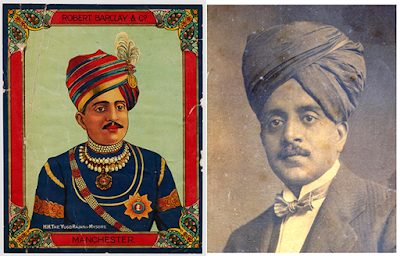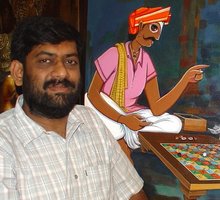Rama Paintings in Rama Mandiras
Worship of Rama, the seventh incarnation (avatar) of Vishnu, is widespread in Hinduism. He is the only deity in the Hindu pantheon who is considered as a king. Temples dedicated to Rama are found across India varying in size and grandeur. The temple at Ayodhya being consecrated recently (22 January 2024) will perhaps outshine many existing Rama temples by its sheer size and magnificence.
The daily worship at a temple is an elaborate ritual involving the presence of several individuals as per hierarchy and the tasks assigned to them are multifarious and a high level of knowledge in customs and practices is essential. Many well-known temples have on roll, priests, cooks, musicians, attenders, so on and so forth.
During the Bhakti movement of the 15th and 16th century, there developed a parallel mode of worship and personal devotion to the chosen deity. In north and central India, wealthy businessmen and landlords (zamindars, subedars, talukdars and jagirdars) patronised a distinct but unique form of worship of Rama and Krishna shorn of grandeur and the imposing temple structures. Large mansions and grand residences housed a shrine dedicated to the Lord, these are referred to as 'Thakurji ki Haveli' (house where the Lord resides). The havelis had a private section where the householders resided and a public section (called as 'baithak') where devotees adhering to the tenets of the sect were allowed to offer prayers and perform small family functions.
The Thakurji ki Haveli among many distinct practices, patronised the Haveli Sangeet - musical renderings extolling the virtues of the Lord sung by vocalists to the accompaniment of musical instruments. A similar tradition of Bhajana Mandira and Rama Mandira was prevalent in parts of Karnataka, Tamil Nadu and Andhra Pradesh. The mostly inconspicuous structures are akin to the north Indian Havelis, the only difference being that the south Indian mandiras have independent entrance.
These mandiras usually have a central altar wherein a painting of Rama is installed. The mandiras of Andhra Pradesh normally have a reverse glass painting of the Sitarama Kalyana, while the ones in Tamilnadu mostly have a Tanjavur painting of Kodanda Rama. The Rama Mandiras of Karnataka have paintings of Rama Pattabhisheka or Ekanta Rama in Mysore style.
Music plays a major part of worship in Havelis; Rama Mandiras, down South, also patronise music as a part of service to the Lord. Hence, we see the tradition of music concerts conducted during the Rama Navami festivities.
Most of the Rama Mandiras have on display, paintings depicting other Hindu divinities, the popular ones are Rajarajeshwari, Lakshmi, Saraswati, Shiva’s family, Krishna with consorts, Exploits (Bala leelas) of Krishna, episodes from Mahabharata, Bhagavata, puranas and Ramayana.
This article examines a few interesting and unique paintings on display and worship at important Rama Mandiras in and around Mysore. The array of subjects and the artists involved in creating these stunning specimens and the devout patrons who were instrumental in leaving behind this rich legacy, are to be remembered in the civilizational journey of India.
Image 1: This is a simple yet brilliant depiction of King Dasharatha in conversation with sage Rishyashringa, inviting him to perform the Putrakameshti Yaga at Ayodhya. Dasharatha's queens Kaushalya, Kaikeyi and Sumitra stand behind the former with folded hands while the minister Sumantra is shown behind the sage. (Arya Vysya Rama Mandira, Shivarampet, Mysore)
Image 2: A classic masterpiece by an unidentified artist is the naming ceremony (namakarana) of the four little princes. Dasharath is seated in the centre, to his right queen Kaushalya is cradling the baby Rama and on the King's left, queen Sumitra holds the twins Lakshmana and Shatrughna and on the far left, queen Kaikeyi cradles Bharata. Royal priests and sages with hands raised, bless the royal family. (Private collection)
Image 3: The wedding (kalyana) of the four princes of Ayodhya. The painting effectively illustrates the grandeur associated with the celebration in the central panel which divides into four individual mantapas where the weddings are being performed simultaneously. The lower register has episodes from Ramayana culminating up to the Seeta swayamvara while the upper register depicts the event of the swayamvara. (Rama Mandira attached to the Hattu Janagala Garadi at Paduvarahalli)
Image 4: Packed with dramatis personae involved in the last siege and defeat of Ravana, this classic jewel of a painting depicts the worship of Shivalinga at Rameshwaram by Rama and Sita as atonement for the killing of Ravana. The heavily decorated ornate arch and pillars are reminiscent of the Mysore palace. The artist has very imaginatively and skillfully placed the characters one above the other as seen at royal events. (Kunchitigara Rama Mandira, Santhepet, Mysore.)
Image 5: In this masterpiece by an unknown artist, Rama and his huge entourage await the arrival of Pushpaka Vimana along with Vibhishana to depart the hermitage of sage Bharadwaja. Hanuman, the wise Jambavan and the other simian generals with folded hands thank the sage for having served them with sumptuous meal provided by the grace of wish fulfilling divine cow, Nandini, the daughter of Kamadhenu, seen at the top left corner. (Dodda Garadi Rama Mandira at Srirangapatna)
Image 6: The painting of Sampoorna Ramayana depicted within the Sudarshana Chakra by artist Parashurama Alasingalachar is a masterpiece. The painting has a register style of story narration. On the top left corner, Vishnu is shown reclining on the serpent Adishesha in Vaikunta, the right-side corner depicts the ancestral deity worshipped by the Ikshvaku clan. Rama and his three brothers offer flowers to the moolamurthy and the utsava murthy of Ranganatha. The bottom left depicts Brahma flanked by Saraswathi and Narada while on the right, Narada narrates the story of Rama to sage Valmiki. (Karagam family, Melkote)
Image 7: The direct confrontation between Rama and Ravana at Lanka is the subject of this painting. Taking aim at each other with the extended bow, a faint smile on Rama’s face perhaps signifies the outcome of this duel. Here, Rama is shown bigger than Ravana, in size, to emphasise the divinity of Rama. (Bestara Rama Mandira, Tilaknagar, Mysore)
Image 8: This painting depicts the twins Lava and Kusha ensconced on their parents’ lap with their uncles in attendance. Raja Guru, Maharshi Valmiki presents the horoscope (jataka) and Hanuman pays obeisance to their lordships. This is a fine specimen of Mysore painting with superb gesso and gold work by artist Durgada Krishnappa. (Rama Mandira, Talkad)
Image 9: Shivageeta is one of the esoteric books which focuses on an episode from Ramayana where Rama and Lakshmana are searching for the abducted Sita in the forest and they visit several hermitages and meet sages. The brothers are accorded darshan by Shiva and Parvati and in one instance Shiva reveals his cosmic form, Vishwaroopa. Thus, this interesting specimen of the Mysore school narrates a rare episode. (Javaratti Rama Mandira, Veeranagere, Mysore)
Image 10: Among the most famous Rama Mandiras of the city is Bidara Rama Mandira having one of the most magnificent interiors and a fine collection of paintings. This painting of Kodanda Rama by an unknown master is a fine specimen from the early 20th century. This is a fairly popular subject in the Mysore school. (Bidara Krishnappa’s Sri Prasanna Sita Rama Mandira, Mysore)
Image 11: The grandeur of the coronation ceremony of Rama is well depicted in this painting. The artist has imaginatively placed maximum number of subjects within every available space in the painting. (Sri Venkateshwara temple, Tilaknagar, Mysore)
Image 12: In this painting the artist has beautifully captured the anointment of Rama during the coronation ceremony (pattabhisheka). Two sages pour the consecrated water on Rama while five sages seated below chant benedictory verses. In front of Rama with folded hands are his siblings and behind Sita are their spouses. (Thimmarasappa’s Rama Mandira, Bestageri, Nazarbad, Mysore)
Image 13: After the coronation of Vibheeshana following the death of Ravana, Vibheeshana summons Pushpaka Vimana to ferry Rama, Sita, Lakshmana, Hanuman, himself and the huge entourage of the simian army who are eager to visit Ayodhya for the coronation. This painting by artist B.P. Ramakrishna captures the essence of the arial flight of this wonder of a vehicle which can comfortably accommodate any number of passengers. (Collection: Mrs. Pushpa Krishnaiyengar, Bangalore)
All the paintings used
in this article are in the Mysore school, housed at the mentioned Rama Mandiras
(or otherwise), and the copyright is reserved by the respective individuals/Trusts/Mandiras.
The paintings were photographed by H.S. Dharmendra Raghu between 2015-2020.



















































